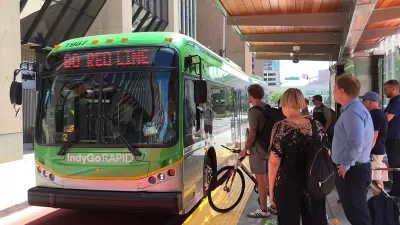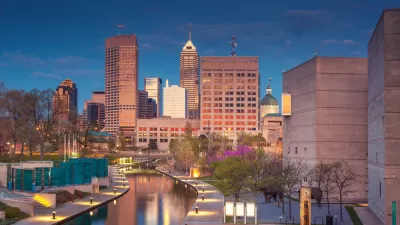With federal support from the Obama Administration's LadderSTEP program now secured, Indianapolis' $1.2 billion proposal for mass transit upgrades has new momentum.
"Central Indiana's bus rapid transit plan appears to be gliding toward reality," reports John Tuohy, "with a boost Thursday from the nation's transportation head and plans to apply for a $50 million construction grant."
Indianapolis is already well underway with planning for the Red Line—the first leg of the proposed system. Tuohy provides details:
"The Red Line is a proposed 28-mile, $100 million electric bus route from Westfield to Greenwood with several dedicated lanes and raised platforms. Nearly 170,000 people work within a half-mile of the route, and tens of thousands more live close to it, many in low-income neighborhoods."
Additionally, reports Tuohy:
"The Red Line would be one of five crisscrossing the city in the $1.2 billion system — called Indy Connect — and it's anticipated that they would prompt development nearby."
Tuohy's coverage was prompted by a visit from U.S. Transportation Secretary Anthony Foxx, who rode one of the system's electric buses along part of the proposed Red Line route, joined by Indianapolis Mayor Greg Ballard, who has been pushing for the Indy Connect investment for years.
Secretary Foxx also announced that the Red Line would participate as one of seven pilot cities in the LadderSTEP program, which enlists the help of non-profit organizations for planning and development support. The non-profits that will assist the Red Line are as follows: LOCUS, the Urban Land Institute, Enterprise Community Partners, the natural Resources Defense Council, and the Local Initiatives Support Group.
FULL STORY: Indy's rapid transit plan moving fast

Alabama: Trump Terminates Settlements for Black Communities Harmed By Raw Sewage
Trump deemed the landmark civil rights agreement “illegal DEI and environmental justice policy.”

Planetizen Federal Action Tracker
A weekly monitor of how Trump’s orders and actions are impacting planners and planning in America.

The 120 Year Old Tiny Home Villages That Sheltered San Francisco’s Earthquake Refugees
More than a century ago, San Francisco mobilized to house thousands of residents displaced by the 1906 earthquake. Could their strategy offer a model for the present?

In Both Crashes and Crime, Public Transportation is Far Safer than Driving
Contrary to popular assumptions, public transportation has far lower crash and crime rates than automobile travel. For safer communities, improve and encourage transit travel.

Report: Zoning Reforms Should Complement Nashville’s Ambitious Transit Plan
Without reform, restrictive zoning codes will limit the impact of the city’s planned transit expansion and could exclude some of the residents who depend on transit the most.

Judge Orders Release of Frozen IRA, IIJA Funding
The decision is a victory for environmental groups who charged that freezing funds for critical infrastructure and disaster response programs caused “real and irreparable harm” to communities.
Urban Design for Planners 1: Software Tools
This six-course series explores essential urban design concepts using open source software and equips planners with the tools they need to participate fully in the urban design process.
Planning for Universal Design
Learn the tools for implementing Universal Design in planning regulations.
Clanton & Associates, Inc.
Jessamine County Fiscal Court
Institute for Housing and Urban Development Studies (IHS)
City of Grandview
Harvard GSD Executive Education
Toledo-Lucas County Plan Commissions
Salt Lake City
NYU Wagner Graduate School of Public Service




























